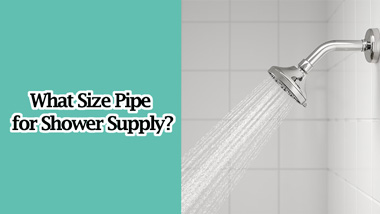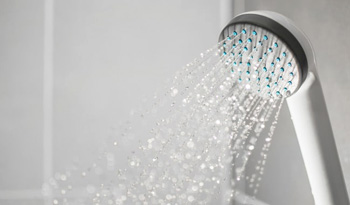Installing or repairing a shower supply pipe is one of the easiest DIY projects anyone can do. However, success is not guaranteed, so knowing which pipe sizes to use is a good way to avoid flooded houses and damp ceilings. What size pipe for shower supply?
A typical shower supply pipe is ½ inches in diameter. However, you can attach a ⅜ inch, ½ inch, or even a ¾ inch diameter pipe. Smaller pipe diameters reduce the water flow rate, saving water, while the larger diameters allow higher flow and water pressure.
Before you repair or install a new shower supply line, you have to choose the appropriate pipe size for your shower. Here’s how pipe size affects pressure, the factors that determine pipe size, and why you shouldn’t install oversized pipes.
What Size Pipe For Shower Supply?

The most common size for shower supply pipes is ½ inch. Two lines, hot and cold, supply water to the shower. A valve is used to regulate the temperature and flow rate of water going to the shower head. This supply is connected to a ¾-inch pipe which is the typical water pipe size for a bathroom supply.
The shower supply pipe size is critical because it affects the water pressure and flow to the shower head. A larger diameter pipe increases the water flow rate while a small one has less water flowing through.
Most old or renovated homes use copper or galvanized steel pipes for the shower supply line. However, cross-linked polyethylene or PEX has become the preferred pipe in modern plumbing. PEX is flexible, cheap, and easy to work with.
The easiest way to choose shower supply pipe size is by checking a plumbing pipe size chart. The chart provides the recommended pipe sizes depending on several factors so that you never have to manually calculate sizes.
Sometimes, the pipe size of the shower supply is influenced by water saving. Since a ½-inch pipe reduces water flow, the shower fixture will waste less water than a ¾-inch pipe. However, it will take longer to shower than if the supply pipe were ¾ inch in diameter.
PEX pipes come in three sizes, namely, ⅜ inch, ½ inch, and ¾ inch. If you wish to save as much water as possible while showering and don’t mind spending longer in the shower, you can use a ⅜-inch PEX supply.
Copper pipes have a larger internal diameter compared to PEX pipes. If you’re replacing copper pipes with PEX, use a larger diameter. For instance, a ½-inch copper pipe will be replaced by a ¾-inch PEX pipe.
Plumbing pipe size chart
| Pipe Size (NPS) | Inside Diameter (inches) | Outside Diameter (inches) |
|---|---|---|
| 1/8 | 0.405 | 0.54 |
| 1/4 | 0.54 | 0.84 |
| 3/8 | 0.675 | 1.05 |
| 1/2 | 0.84 | 1.315 |
| 3/4 | 1.05 | 1.66 |
| 1 | 1.315 | 1.9 |
| 1 1/4 | 1.66 | 2.375 |
| 1 1/2 | 1.9 | 2.875 |
| 2 | 2.375 | 3.5 |
| 2 1/2 | 2.875 | 4 |
| 3 | 3.5 | 4.5 |
| 4 | 4.5 | 5.563 |
| 5 | 5.563 | 6.625 |
| 6 | 6.625 | 7.625 |
| 8 | 7.625 | 9.625 |
| 10 | 9.625 | 10.75 |
| 12 | 10.75 | 12.75 |
Does Shower Pipe Size Affect Water Pressure?
Yes, shower pipe size directly affects the water pressure. According to Bernoulli’s principle, water pressure decreases when it goes through a small pipe and increases in a larger pipe.
When water flows from a big pipe into a smaller pipe, its speed increases. Consequently, the water molecules don’t interact with the walls of the pipe very much, resulting in a pressure drop. In a larger pipe, speed is lower, so the water molecules collide with pipe walls causing more pressure.

Hence, if your shower pipe size is smaller than the size of the shower supply line, the water pressure will drop. If the shower pipe size is equal to the supply line, water pressure will also be equal.
Water pressure drops for every foot that a supply pipe rises above the water supply. Whether a shower is on the third floor or in the basement, the water pressure must be similar across the board. Hence, to ensure pressures are equal, pipes supplying the third floor are larger than ground floor pipes.
When trying to repair or install new showers yourself, check the plumbing pipe size chart for the correct pipes to use.
What Happens If Shower Pipe Is Oversized?
If the shower pipe is larger than the ¾-inch supply line, the water pressure toward the shower structure will increase. More water will flow through the shower structure and at higher pressure. If the shower fixture cannot handle higher water volumes and high pressures, it will break.
If a shower pipe is oversized, it will have a higher flow of water than the standard ½-inch pipe. Hence, when using hot and cold water, the hot water will take longer to reach the shower if the pipe is oversized.
What Factors Affect Pipe Size For Shower Supply?
The standard water pipe size for house supply is ¾ inch. This pipe size gets downsized to ½ inch diameter when supplying individual components like sinks and showers. However, there are several factors to consider when choosing the pipe size, including elevation and pressure.
Number of fixtures
The total number of fixture units determines how much demand you’ll have for water in your bathroom. The plumbing manual has a fixture value and corresponding pipe size for each fixture unit.
Distance from the housing supply
This distance is measured between the house supply pipe and the outlet in the shower. To get an accurate measurement, you must calculate the distance, from the water meter to the shower head, including horizontal and vertical pipes.
Longer pipes have lower flow rates than shorter pipes of the same diameter. Hence, if the distance of the shower from the housing supply is long, you may need to adjust the pipe size accordingly.
Elevation
Water pressure drops by approximately 0.5 psi for a one-foot rise and increases by 0.5 psi for a one-foot drop. Calculate the vertical distance of the shower fixture in relation to the house water supply to find out the expected pressure drop.
Effect Of Shower Head On Shower Supply Pipe Size
Depending on what you need, you may explore various shower options with different water pressure and volume requirements. The options include rain shower heads, double shower heads, or even water jets.
A rain shower head is typically 6 to 12 inches wide. It produces a water spray that feels like rainfall at a rate of 2.5 gallons per minute. When using the ½-inch pipe for rain shower head, the water spray is weaker for a larger diameter than for a smaller one.
Double shower heads come with a fixed shower head and a handheld one. The flow rate usually is 2.5 gallons per minute, so having both on at the same time gives you 1.25 for each. A larger shower supply pipe size can increase the flow rate and allow you to use both heads simultaneously.
A water jet shower has several small jets positioned at various points on the wall so that the water reaches the whole body. They require a good volume of water to perform effectively, so a larger shower supply pipe is better.
Typically, the shower supply line is a ¾-inch pipe, and the shower pipe size is ½ inch. However, the different types of showers have different water flow and pressure demands. For instance, the ½-inch pipe coupled with a 12-inch rainfall shower head results in a weak spray compared to a 6-inch one.
Hence, when comparing ¾ inch vs ½ inch plumbing, the flow requirements of the shower head will determine what you settle on. A typical shower head will work perfectly with a ½-inch shower pipe size. However, a large rainfall shower or water jet may require a ¾-inch shower pipe.
Conclusion
The standard water pipe size for house supply is ¾ inch in diameter. However, for individual fixture units like sinks in the house, a ½-inch pipe size is preferred.
Shower supply pipe size is affected by factors such as elevation, distance from the water meter, and the number of fixtures. Computing the effects of these factors is complicated, but thankfully, you can use a plumbing pipe size chart to choose pipes.
Most showers are typically supplied by ½-inch pipe size. You can, however, use a ¾-inch pipe if your shower heads require a high water flow rate and pressure.